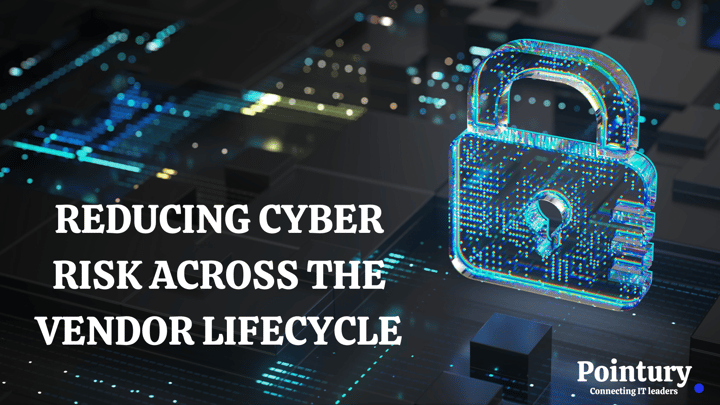REDUCING CYBER RISK ACROSS THE VENDOR LIFECYCLE

Reducing Cyber Risk Across the Vendor Lifecycle:
A Comprehensive Approach
In today's interconnected business landscape, organisations increasingly rely on third-party vendors to deliver essential services and products. While this strategic approach can enhance efficiency and innovation, it also introduces cyber risks that organisations must actively manage. Establishing a robust vendor risk management process that encompasses all stages of the vendor lifecycle is essential for reducing vulnerabilities and safeguarding your organisation's data and operations.
In this article, we'll explore the various stages of the vendor lifecycle, best practices for managing cyber risk at each stage, and how a strong Supply Chain Defence solution can bolster your Third-Party Risk Management (TPRM) program.
The Vendor Lifecycle: A Holistic Approach
The vendor lifecycle comprises several critical stages, each presenting unique cyber risk challenges and opportunities for mitigation:
-
Vendor Onboarding: This stage involves selecting and onboarding a vendor. It's crucial to assess a vendor's cybersecurity posture, evaluate their compliance with industry standards and regulations, and establish clear security expectations from the outset.
-
Contract Negotiation: During this phase, organisations should include comprehensive cybersecurity clauses and Service Level Agreements (SLAs) in contracts. Specify security responsibilities, incident response procedures, and compliance requirements to ensure alignment.
-
Ongoing Monitoring: Continuously monitoring vendor activities and security measures is essential. Employ threat intelligence to detect potential vulnerabilities and breaches in real-time. Regularly review vendor performance against established security standards.
-
Incident Response: In the event of a security breach or incident involving a vendor, having a well-defined incident response plan that includes vendor-specific protocols is crucial. Collaboration and swift action can mitigate damage.
-
Renewal and Review: Periodically reassess your vendor relationships and evaluate whether they continue to meet your security requirements. Adjust contracts and expectations as necessary to align with evolving threats and business needs.
Best Practices for Cyber Risk Reduction
To effectively reduce cyber risk across the vendor lifecycle, consider implementing these best practices:
-
Risk Assessment: Prioritise vendors based on their criticality to your operations. Conduct thorough risk assessments, taking into account their access to sensitive data and systems.
-
Cybersecurity Due Diligence: Before onboarding a vendor, perform due diligence to assess their cybersecurity capabilities. Review their security policies, incident response plans, and third-party audit reports.
-
Contractual Protections: Include cybersecurity requirements in vendor contracts, outlining security standards, data protection measures, and incident reporting protocols.
-
Continuous Monitoring: Employ automated tools and threat intelligence to continuously monitor vendor activities and security measures. Set up alerts for suspicious behavior or potential vulnerabilities.
-
Incident Response Plans: Develop incident response plans specific to vendor-related incidents. Clearly define roles and responsibilities for both your organisation and the vendor in the event of a breach.
-
Education and Training: Provide cybersecurity training to both your employees and vendor personnel who have access to your systems or data.
Leveraging Supply Chain Defence Solutions
A strong Supply Chain Defence solution can significantly enhance your TPRM program's effectiveness, regardless of its current gaps or maturity. Here's how:
-
Visibility: These solutions provide visibility into your entire vendor ecosystem, helping you identify and assess all vendors, even those that may not be on your radar.
-
Automation: Supply Chain Defence solutions automate the collection of security data and the monitoring of vendor compliance, enabling real-time risk assessment.
-
Analytics: Advanced analytics help organisations identify patterns and anomalies within vendor behavior, enhancing the ability to detect potential threats.
-
Scalability: These solutions can scale as your vendor ecosystem grows, accommodating both small and large-scale TPRM programs.
-
Threat Intelligence: Integration with threat intelligence feeds provides early warnings about emerging threats and vulnerabilities in your vendor network.
Conclusion
In an era of increasing vendor reliance, organisations must prioritise vendor risk management to protect their data and operations. A comprehensive approach that addresses all stages of the vendor lifecycle, coupled with best practices and a robust Supply Chain Defence solution, can significantly reduce cyber risks. By implementing these measures, organisations can strengthen their cybersecurity posture, foster trust with vendors, and mitigate the potential financial and reputational damage associated with vendor-related breaches. Remember, reducing cyber risk is not only a responsibility but also a strategic advantage in today's interconnected business landscape.


